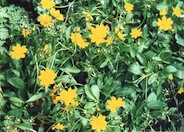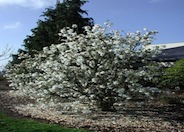
Common name:Sea Lavender, Statice
Botanical name:Limonium perezii
This mounding shrub will reach about 3' high and has large, dark green leaves with small blue and purple flowers that bloom in spring and summer.

Common name:Sea Pink, Common Thrift
Botanical name:Armeria maritima
This clumping, grass-like perennial is native to many areas, including coastal CA. Its flowers range from deep rose pink through white. -Monterey Bay Nursery

Common name:Dwarf Eared Coreopsis
Botanical name:Coreopsis auriculata 'Nana'
A low, mat-forming perennial to 2' wide, the 'Nana' bears deep orange yellow flowers on short stalks from spring through fall (if deadheaded faithfully), and occasionally into winter. It requires sun and average watering. -Monterey Bay Nursery

Common name:Liquidambar, American Sweet Gum
Botanical name:Liquidambar styraciflua
A tall, deciduous tree of upright, pyramidal habit, the Liquidambar has dark green, maple-like leaves that turn beautiful shades of red and yellow in the fall season. It can be used as a single specimen, hedge, or grouped plant.

Common name:Catmint
Botanical name:Nepeta X faassenii
Nepeta faassenii makes soft, gray green, undulating mounds that are 1.5' high when blooming. The small leaves are attractive to cats. This perennial has lavender blue flowers in late spring and early summer.

Common name:Star Magnolia
Botanical name:Magnolia stellata
This slow-growing, shrubby, deciduous Magnolia has narrow leaves about 4" long and 1" wide. These fragrant flowers, borne in the early spring before leaves, are white, with 19-21 star-shaped petals.

Common name:Hybrid Daylily (various)
Botanical name:Hemerocallis hybrids
These summer-blooming perennials form clumps with large, grass-like leaves. Its showy flowers, resembling lilies, are borne in clusters on stems held well above the foliage. They prefer full sun to light shade, well draining soil that is slightly acidic and rich. They do better with deep watering once a week. Daylilies make excellent cut flowers. Apply a layer of compost every fall.
Sustainable Landscaping Fundamentals
Sustainable landscaping is a term coined to mean sensible landscape practices that work within the limits of the Eco-system. This means within the limits of your local rainfall, soil conditions and sun patterns.
Click in the green box for more information
| Designer: | Treatment by the House |
Photographer: GardenSoft |
Soils and Compost:
Maintain a two to four inch layer of mulch on the soil surface to reduce weeds, infiltrate rain water, and reduce compaction.
Water Saving Tip:
Mulching and adding compost to soil can minimize evaporation and help soil absorb and store water.
Integrated Pest Management:
Drip and other smart irrigation delivers water directly to roots, allowing no excess water for weeds.

